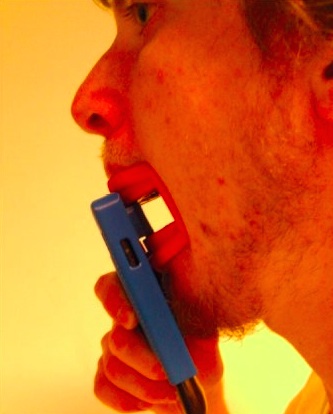 Stanford University's Prakash Lab has developed a smartphone peripheral to diagnose oral cancer, called Oscan.
Stanford University's Prakash Lab has developed a smartphone peripheral to diagnose oral cancer, called Oscan.
The peripheral device has a mouthpiece and a camera mount. Users follow the upper and lower bite guides to help them take the desired shots of the inside of their mouth.
According to the researchers, screenings of the oral cavity can identify a number of diseases, including submucus fibrosis, gingivitis, and oral cancer.
"For example, 400,000 cases of oral cancer are reported world-wide, one third of which are reported in developing countries with less than one doctor for every 50,000 patients," the researchers' patent filing says. "Tobacco chewing and smoking is the primary driver for the same, where 70 percent of world tobacco consumption is in developing countries. Late discovery of an oral cancer has survival rates of 50 percent while early stage detection can improve the rate to more than 90 percent."
Some companies have been working to prevent oral cancer at earlier stages. In 2012, Aetna conducted a trial program that equipped New York City-area dentists with iPads to help them better educate their patients about tobacco use in an effort to curb smoking. The trial program included a clinical decision support system that was built on a medical knowledge base, patient data, and decision support technology that provided dentists with personally targeted advice for each patient.
Engineers at Princeton University developed another tool for diagnostic testing in the oral cavity in June 2012 -- a tattoo-like dental sensor that detected bacteria that could cause surgical infections and stomach ulcers. The sensor used nanosensors made from a carbon-based substance called graphene and a tiny antenna coil formed from gold wires to monitor breathing and saliva, then transmit readings wirelessly.















